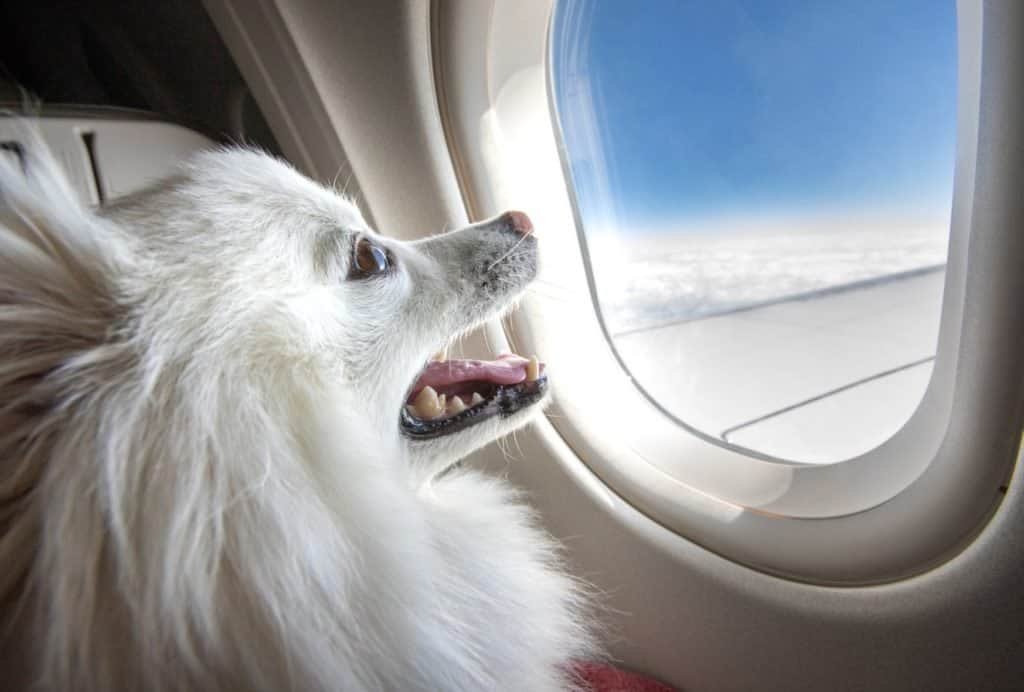
Are you planning to go on a longer holiday or even move cross-country and are wondering if you can bring your dog along?
If so, your next question probably is: is it safe for dogs to fly in cabin?
That’s at least if you own a small dog. Because unfortunately, larger dogs are only allowed to fly in cabin under very strict circumstances, as you’ll see in a minute.
While most dog parents fear that flying in cargo might be stressful or dangerous for dogs (me included), what about flying in cabin?
Here’s the quick answer: With some preparation, it’s absolutely safe to fly with your dog in cabin. In order to have a successful flight, make sure to start preparing well in advance. Check with your airline that your dog is allowed to fly in cabin. Get his carrier early on and crate train him using this carrier. This will make the flight as safe and stress free as possible.
Now let’s look at it in detail.
Table of Contents
Is Flying with Dogs Safe?
You’ve most likely heard horror stories about dogs flying in planes. It’s natural to read these stories and think, “it can’t possibly be safe for my dog to fly with me”.
The good news is that’s far from the truth!
Dogs and cats accompany their owners on flights all the time. The reason so many of these news stories come up is because they’re sensational. The fact is that the percentage of animals that are injured during flights is less than one percent for most airlines.
If you’re planning on flying with your dog, it’s best to research your airline options before buying your ticket. Read reviews, look at the airline’s policies, and make an informed decision.
There are also ways to increase your dog’s safety and comfort when you fly. Let’s take a closer look at some of them.
How Stressful Is Flying for Dogs?
As usual, it depends on the dog. Flying is likely to cause your dog at least a little stress, however. Dogs like routine and things that are familiar, and anything unfamiliar will likely be anxiety-inducing.
So, your dog will likely be stressed during his flight. But there are ways to help him remain calm.
The number one thing is to get him used to his crate. We’ll look at that in a second
It’s also important to consider that if your dog has serious separation anxiety or any other issues, travel by plane might not be the best bet for him. That is – of course – unless he can fly with you in cabin.
You should also always speak to your vet before you board a plane with your dog. Many airlines actually require that you have a health certificate for your pet before flying, so give your vet a call if you’re planning on traveling.
One last consideration before moving on: it may seem logical to give your dog a sedative to keep him calm during his travels. However, there are risks that come with sedation. Sedatives affect your dog’s breathing, heart, and blood pressure. They can also exacerbate underlying health problems.
USA Today has a thorough article on other myths about flying with animals. It’s an article worth checking out!
Crate training is the best way to keep your dog relaxed during flights. In fact, it’s been found that dogs who like their crates and are excited to be in them are generally very calm and comfortable during flights.

Flying with a Large Dog
If you’re traveling with your German Shepherd or your Mastiff, he probably won’t be able to join you in the cabin.
Most airlines have a 20-pound weight limit, so your big dog will likely have to travel as checked baggage.
You may or may not have to put his crate on the same conveyor belt as your suitcase, and your dog will spend the flight in the pet cargo area of the plane.
Concerned that the temperature won’t be regulated? Don’t worry, the temperature of the pet cargo is regulated just like the cabin’s. Your dog shouldn’t be too hot or too cold in there.
At the end of the flight, you’ll pick your dog up in his crate along with your other luggage or, depending on the airline, a special holding area for pets.

Flying with a Small Dog
If you have a small dog, you’re in luck! As long as he stays in an approved carrier, and is stowed under the seat like regular carry on, he’ll be able to ride in the cabin with you.
While it’s entirely possible to fly with a large dog, and the experience doesn’t have to be too stressful with the right preparation, flying with a small dog is generally a little easier.
Plus, you’ll be able to see each other during the flight, which will ease nerves for both you and your dog.
Flying with an ESA or Service Dog
Emotional support animals (ESAs) and service dogs are dogs that assist their owners with emotional, physical, or mental impairments.
American Airline’s complete list of rules for traveling with service dogs is a good example of the types of rules that apply to ESAs and service dogs. The short of it is that usually the animal must be registered as a service animal, he must be able to fit at your feet, be clean and well-mannered, and over 4 months old.
Is It Safe for Dogs to Fly in Cabin?
As you can see, flying with dogs is generally very safe!
Now, let’s look at how safe it is for dogs to fly in cabin.
If you want to learn more about what to consider in general when flying with a dog in cabin, make sure to check out my article on how to manage a long flight with a dog in cabin.
What Kinds of Dogs Fly in Cabin?
The kinds of dogs that are allowed to fly with you in cabin depends on each individual airline and their own rules.
As outlined earlier, smaller dogs under 20 pounds will most likely be able to stay with you, as long as their carrier fits under the seat. ESAs and service dogs will also be allowed, as long as they fit the airline’s list of rules. That’s pretty much the only exception of larger dogs being able to fly in cabin.
Some airlines also hold restrictions on age. Most airlines will require your dog to be at least two months old before he flies in cabin with you.

Possible Dangers for Your Dog When Flying in Cabin
If your dog is small enough to fly with you in cabin, there isn’t much you’ll need to worry about.
As long as you’ve trained your dog to be comfortable in his crate or carrier, and he’s had some exercise and the chance to relieve himself before boarding, he should be content.
In the cabin, a dog will experience essentially the same dangers you will. Prepare for nausea and vomiting by not feeding him until you land, so he’s flying on an empty stomach. Crate train him beforehand to help ease anxiety.
And always visit your vet before heading to the airport and discuss any individual concerns you may have about your dog’s health while flying.
Do Dogs Struggle with Pressure When Landing?
Your dog’s ears are sensitive and just like us, can “pop” with altitude changes. While flying with your dog, both of you are likely to feel the pressure in your ears.
One way to help your dog is to give him something to chew. Humans chew gum while flying to help relieve pressure in our ears. Your dog’s ears work essentially the same way. So give your dog a chew toy to gnaw on, which will help with the pressure he feels.

How Can I Make Flying with My Dog in Cabin as Safe as Possible?
Okay, flying with a dog is really safe, in cargo and in cabin.
The only major safety concern you could have for your dog while flying is stress.
So, let’s quickly look at how you can make flying with your dog in cabin as safe and stress free as possible.
Get a Soft Crate/Carrier with the Right Dimensions
The first thing you’ll want to do is buy an appropriate carrier.
Make sure it’s well ventilated and is the right size so it can fit under the seat in front of you. For most airlines, those dimensions are 18.5 inches (47cm) long by 8.5 (21.5cm) tall by 13.5 (34cm) wide.
Check with your preferred airline for their specific requirements.
For my last flight with Baloo I use this carrier. This is the best option in my opinion. The extendable side gives your dog much more space to sleep while on the airplane.

Make Sure Your Dog Knows and Loves His Carrier
As stated before, dogs who are familiar with and enjoy being in their crates or carriers will generally be much less anxious when flying.
Make sure to buy it well in advance of your trip (as in at least weeks before) so your dog can get used to it. Treat and reward him when he’s inside, and follow all the usual crate training rules.
If your dog knows and loves his carrier, he’ll be much more comfortable on the flight.
Check out dogpackr.com’s previous article about the importance of crate training, and how to get your dog to love his crate. Since he’ll be spending a lot of time in it, it’s good to get him used to it. Plus, he’ll feel more comfortable in his “den”, somewhere that’s familiar to him.

Give Him a Non-Smelly Chewy During Landing
Having something to chew on will help your dog relieve pressure in his ears, while also keeping him busy and focused on something other than the flight. Just make sure it’s not something that’s stinky so you don’t disturb your neighbors!
Something like antlers is probably the best option.
Stay Calm
Dogs are emotional animals and can tell when you’re stressed. If they catch on to your anxiety, that will only make them more anxious.
As you’re getting ready for your flight, take a deep breath, and remember to stay calm. If your dog sees that you’re not worried, that will help him stay calm too.
Talk to Your Vet
Since most airlines require a health certificate for your dog before boarding the plane, you’ll have to go see your vet anyway.
If you have any other concerns about flying, talk to your vet about it while you’re there. Outline your travel plans, discuss any medications your dog is already on, and take your vet’s advice.
Conclusion
There’s no doubt about it—flying with your dog can be stressful!
But as long as you provide the proper training and preparation beforehand, flying doesn’t have to be the horrible experience you might worry it could be. While preparing your dog for flying can take a while, it’s worth it! And especially flying in cabin is definitely the safest option for your dog.
If you’re flying with your dog in cabin, invest in an appropriate soft carrier, train your dog to love it, and talk to your vet next time you visit about your future travel plans.
And don’t forget to bring your camera to take plenty of cute photos of your dog on your adventures!
If you’d rather use another means of transportation with your dog, check out these articles next:
- Essential guide for traveling with a dog in a car
- How to travel to Europe by boat with a dog
- How to travel with a dog without a car
*Disclosure: This post may contain affiliate links, meaning, I get a commission if you decide to make a purchase through one of my links, at no cost to you.

